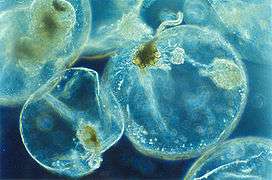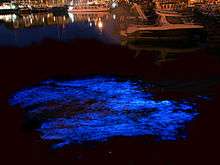Noctiluca scintillans
Noctiluca scintillans, commonly known as the sea sparkle,[1] and also published as Noctiluca miliaris, is a free-living, marine-dwelling species of dinoflagellate that exhibits bioluminescence when disturbed (popularly known as mareel). Its bioluminescence is produced throughout the cytoplasm of this single-celled protist, by a luciferin-luciferase reaction in thousands of spherically shaped organelles, called scintillons.
| Noctiluca scintillans | |
|---|---|
 | |
| Scientific classification | |
| Domain: | |
| (unranked): | |
| (unranked): | |
| Phylum: | |
| Class: | |
| Order: | |
| Family: | |
| Genus: | Noctiluca |
| Species: | N. scintillans |
| Binomial name | |
| Noctiluca scintillans (Macartney) Kofoid & Swezy, 1921 | |
| Synonyms | |
|
Noctiluca miliaris | |
Physical characteristics
N. scintillans is large for a dinoflagellate with a diameter of 0.2–2 mm (0.0079–0.0787 in), though most are around 0.5 mm (0.02 in).[2] It has a ventral groove that holds a flagellum, an extension of the cell wall called a tooth, and a striated tentacle involved in ingestion that projects posteriorly. The flagellum does not move the organism, so the nonmotile N. scintillans depends on regulation of its buoyancy within the water column – perhaps by controlling its cellular concentration of ions and ammonia.
N. scintillans produces a string of mucus extending from the tip of the tentacle which then adheres to plankton and ascends rapidly through concentrations of its prey in the water column.
Diet

N. scintillans is a heterotroph that engulfs, by phagocytosis, food which includes plankton, diatoms, other dinoflagellates, fish eggs, and bacteria. Diatoms are often found in the vacuoles within these single-celled creatures. These green nonfeeding symbioses can grow photoautotrophically for generations.[3] Diatoms of Thalassiosira have been noted as a favored food source of these organisms.
Distribution
N. scintillans can be found widely distributed throughout the world, often along the coast, in estuaries, and shallow areas of the continental shelf that receive plenty of light, which promotes the growth of the phytoplankton that make up a large portion of the N. scintillans diet.
Life cycle
Noctiluca species are unusual among dinoflagellates in appearing to have a diplontic life cycle.[4]
"Blooms"
N. scintillans populations can exhibit high concentrations due to high concentrations of the plankton on which they feed, which are likely due to environmental conditions such as well-mixed, nutrient-rich waters, seasonal circulation, and runoff from agricultural pollution.
The glow produced by N. scintillans organisms can be perceived by humans as ghostly colored glow or bloom in the water, which appears when the water is disturbed. This gives N. scintillans the popular names "sea ghost" or "fire of sea".[5][6]
Bloom color partly derives from the pigments of organisms inside the vacuoles of N. scintillans. Blooms are often red in coastal areas of the North Sea.[7] Green tides result from N. scintillans populations having green-pigmented prasinophytes (green algae, subphylum Chlorophyta)[8] living in their vacuoles.
N. scintillans does not appear to be toxic, but it feeds voraciously on phytoplankton, and while doing so, it accumulates and excretes high levels of ammonia into the surrounding water. This may add to the neurotoxins produced by other dinoflagellates, such as Alexandrium or Gonyaulax (syn. Lingulodinium) spp., that kill off other aquatic life in the area.
Evolutionary development
DNA sequence comparisons suggest that the closest relative of the genus Noctiluca is Spatulodinium. Spatulodinium pseudonoctiluca seems to be more closely related to N. scintillans than to other Spatulodinium species.[9] N. scintillans is also placed within a classification scheme that has a class Diniferea, or Dinophyceae, which includes nonparasitic dinoflagellates that lack armor plating.[10]
References
- "Image of the "Sea Sparkle" from 'Britannica Online Encyclopedia'". Britannica.com. Retrieved 2013-09-13.
- "Noctiluca scintillans". University of Tasmania, Australia. Retrieved 5 January 2020.
- Saito, Haruna; Furuya, Ken; Lirdwitayarpasit, Thaithaworn (2006). "Photoautotrophic growth of Noctiluca scintillans with the endosymbiont Pedinomonas noctilucae". Plankton and Benthos Research. 1 (2): 97–101. doi:10.3800/pbr.1.97.
- Zingmark, R.G. (1970). "Sexual reproduction in the dinoflagellate Noctiluca miliaris Suriray". Journal of Phycology. 6 (2): 122–6. doi:10.1111/j.1529-8817.1970.tb02369.x.
- "Lights in Irish Sea are natural". Irish Times. 18 October 2009.
- Fry, Hannah (2020-04-28). "Glowing blue waves lighting up SoCal coastline roll into the South Bay". Los Angeles Times. Retrieved 2020-05-01.
- Hasle, Grethe R.; Syvertsen, Erik E.; Steidinger, Karen A.; Tangen, Karl; Tomas, Carmelo R. (1996). "3. Dinoflagellates § Identification of Species". Identifying Marine Diatoms and Dinoflagellates. Academic Press. pp. 465–. ISBN 978-0-08-053441-1.
- Pascher A (1914). "Über Flagellaten und Algen". Berichte der Deutschen Botanischen Gesellschaft. 32: 136–160.
- Gómez F, Moreira D, López-García P (2010). "Molecular phylogeny of noctilucoid dinoflagellates (Noctilucales, Dinophyceae)" (PDF). Protist. 161 (3): 466–478. doi:10.1016/j.protis.2009.12.005. PMID 20188628.
- Hausmann, Hülsmann & Radek 2003
Further reading
- Eckert R, Reynolds GT (1967). "The subcellular origin of bioluminescence in Noctiluca miliaris". Journal of General Physiology. 50 (5): 1429–58. doi:10.1085/jgp.50.5.1429. PMC 2225713. PMID 5340466.
- Elbrächter, M.; Qi, Y.Z. (1998). "Aspects of Noctiluca (Dinophyceae) population dynamics". In Anderson, Donald Mark; Cembella, Allan D.; Hallegraeff, Gustaaf M. (eds.). Physiological Ecology of Harmful Algal Blooms. NATO ASI series: Ecological sciences. 41. Springer. pp. 315–335. ISBN 978-3-540-64117-9.
- Hausmann, Klaus; Hülsmann, N.; Radek, Renate (2003). Protistology (3rd ed.). E. Schweizerbart'sche Verlagsbuchhandlung. ISBN 978-3-510-65208-2.CS1 maint: ref=harv (link)
- Lenaers G, Scholin C, Bhaud Y, Saint-Hilaire D, Herzog M (1991). "A molecular phylogeny of dinoflagellate protists (Pyrrhophyta) inferred from the sequence of 24S rRNA divergent domains D1 and D8". Journal of Molecular Evolution. 32 (1): 53–63. Bibcode:1991JMolE..32...53L. doi:10.1007/BF02099929. PMID 1901368.
- Murray S, Flø Jørgensen M, Ho SY, Patterson DJ, Jermiin LS (2005). "Improving the analysis of dinoflagellate phylogeny based on rDNA". Protist. 156 (3): 269–86. doi:10.1016/j.protis.2005.05.003. PMID 16325541.
- Palmer, Jefferey D. (2003). "The Symbiotic Birth and Spread of Plastids: How Many Times and Whodunit?". Journal of Phycology. 39: 4–11. doi:10.1046/j.1529-8817.2003.02185.x.
- Tada, Kuninao; Pithakpol, Santiwat; Yano, Rumiko; Montani, Shigeru (2000). "Carbon and nitrogen content of Noctiluca scintillans in the Seto Inland Sea, Japan". Journal of Plankton Research. 22 (6): 1203–11. doi:10.1093/plankt/22.6.1203.
- Kiørboe, Thomas; Titelman, Josefin (1998). "Feeding, prey selection and prey encounter mechanisms in the heterotrophic dinoflagellate Noctiluca scintillans". Journal of Plankton Research. 20 (8): 1615–36. doi:10.1093/plankt/20.8.1615.
- Umani, S. Fonda; Beran, A.; Parlato, S.; Virgilio, D.; Zollet, T.; De Olazabal, A.; Lazzarini, B.; Cabrini, M. (2004). "Noctiluca scintillans MACARTNEY in the Northern Adriatic Sea: long-term dynamics, relationships with temperature and eutrophication, and role in the food web". Journal of Plankton Research. 26 (5): 545–561. doi:10.1093/plankt/fbh045.
External links
| Wikimedia Commons has media related to Noctiluca scintillans. |
- "Noctiluca scintillans". Guide to the Marine Zooplankton of south eastern Australia. Tasmanian Aquaculture & Fisheries Institute. 2011-11-30.